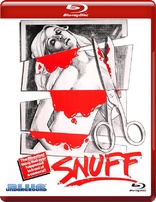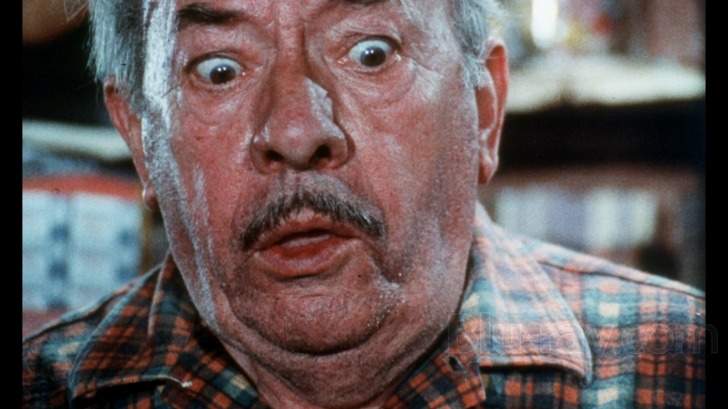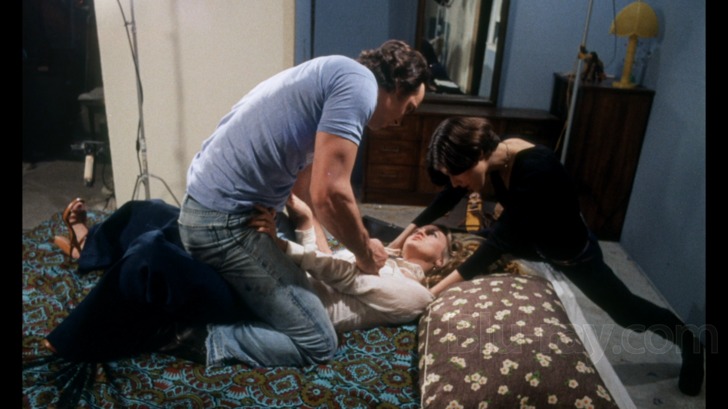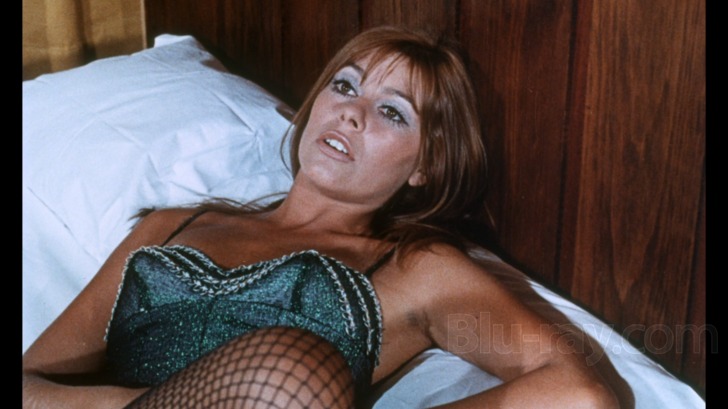Snuff Blu-ray Movie
HomeSnuff Blu-ray Movie 
Blue Underground | 1975 | 80 min | Not rated | Oct 22, 2013
Movie rating
4.9 | / 10 |
Blu-ray rating
| Users | 3.5 | |
| Reviewer | 3.0 | |
| Overall | 3.0 |
Overview
Snuff (1975)
A so-called "snuff" movie involving the exploits of a cult leader leading a gang of bikers in a series of supposedly real killings on film.
Starring: Margarita Amuchástegui, Tina Austin, Ana Carro, Brian Cary, Liliana Fernández BlancoDirector: Simon Nuchtern, Roberta Findlay, Michael Findlay, Horacio Fredriksson
| Horror | Uncertain |
| Thriller | Uncertain |
| Crime | Uncertain |
Specifications
Video
Video codec: MPEG-4 AVC
Video resolution: 1080p
Aspect ratio: 1.67:1
Original aspect ratio: 1.37:1
Audio
English: DTS-HD Master Audio Mono
Subtitles
English SDH
Discs
25GB Blu-ray Disc
Single disc (1 BD)
Playback
Region A, B (C untested)
Review
Rating summary
| Movie | 1.0 | |
| Video | 3.5 | |
| Audio | 3.0 | |
| Extras | 3.5 | |
| Overall | 3.0 |
Snuff Blu-ray Movie Review
History in the faking.
Reviewed by Brian Orndorf February 24, 2014I recognize and respect the movie’s position in the exploitation hall of fame, but let’s not kid ourselves here: “Snuff” is a terrible motion picture. More of a triumph of provocative marketing than a coherent feature, this 1976 endeavor is all about shock value, attempting to work itself under the skin of the viewer with a parade of macabre events and displays of gore, with the very act of anticipation the key to the horror here, not anything actually contained in the effort. Bizarre, deathly dull, and distinctly amateurish, “Snuff” is best left as a ridiculous urban legend, as any exposure to a mere minute of this punch-drunk picture diminishes its power as a nightmare machine using the tease of genuine murder as a way to attract the curious and dubious.

Since a simple synopsis is impossible, perhaps a bit of history is in order. In the mid-1970s, distributor/producer Allan Shackleton was looking for a way to cash in on snuff film fear that was sweeping the nation, horrifying those exposed to reports that women were being murdered on camera, with prints circulated underground. Coming across “Slaughter,” a 1971 movie created by Roberta and Michael Findlay, two seasoned exploitation artists, Shackleton found his moneymaker. Chopping “Slaughter” down to a manageable size, the producer concocted a film-within-the-film conclusion that showcased the murder of an innocent woman at the hands of the crew, with the evil particulars of dismemberment punctuating a drab feature that was largely out to marry “Easy Rider” and the Sharon Tate murders. Playing up the possibility of realism, Shackleton rode a wave of controversy and protests to extraordinary box office returns, preying on the public’s interest in all things snuff and their insatiable need to test the boundaries of screen violence.
“Slaughter” takes up the majority of screen time, following the adventures of a Manson-like figure known as Satan (pronounced “Say-taun”) and his obsessive need to extract the unborn child of a nudie movie actress who’s arrived in Chile to take part in a production and mess around with an old lover. Actual details of the plot are impossible to identify, with merciless editing and potentially idiotic direction destroying coherence, rendering the effort a series of random scenes with a shared interest in excessive violence. It’s difficult to place blame on the Findlays, but several peculiarities suggest the filmmakers weren’t exactly paying close attention during production, including a police headquarters interrogation scene that takes place on an industrial driveway, and the feature’s sudden interest in Israel-Palestine relations -- a sampling of debate that sticks out in picture largely about exposed breasts and carnival footage.
I hate to use the M-word, but “Sacrifice” comes dangerously close to becoming a “Manos: The Hands of Fate” sequel, wandering interminably through Argentina on a vague quest to evoke Manson’s headline-grabbing wrath. There’s a “Born to the Wild” sound-alike grinding away on the soundtrack, a flashback sequence that’s dutifully drained of color but doesn’t actually convey any history, and a parade of skin that submits tan-lines as the official star of the movie. Graphic violence also steals focus, with whippings, mutilations, and shootouts trying to revive a brain-dead film. Too bad spatial relationships, timing, and performance elude the Findlays, burying “Slaughter” alive as it pilfers real-world horror.
Once “Snuff” reaches the 1976 footage, the movie’s out of gas, making its climatic symphony of pain more numbing than insidious. Shackleton doesn’t exactly employ the finest in make-up and direction (reportedly the work of Simon Nuchtern) for the shocker conclusion, while basic human anatomy also mystifies the production -- I’m fairly certain the human heart doesn’t reside in the upper thigh area. The goal here is to watch a woman torn to shreds by a nutcase and his camera crew, but the illusion never takes due to crummy acting, overkill coverage, and visible seams on the special effects. It’s bush league brutality stapled on a comatose picture, leaving “Snuff” all worked up with nowhere to go. It’s difficult to fathom how anyone could believe Shackleton was selling authenticity when the footage was this goofy.
Snuff Blu-ray Movie, Video Quality 

The AVC encoded image (1.67:1 aspect ratio) presentation hasn't been exhaustively restored for its Blu-ray debut, but what's here is in surprisingly decent shape. Perhaps working with limited resources, "Snuff" arrives with refreshed color timing that pushes primaries with success, making hues powerful, with a concentration on red that emphasizes the violence. The print displays its age through fading, while damage is common, along with speckling. Crush is troublesome, solidifying shadowed particulars of the frame, while white levels appear excessively bright. Grain is successfully managed, with a welcome filmic look. Textures are actually achieved during close-ups, with some fine detail surviving, identifying faces and fabrics, and most locations are open for study. Obviously, the "Slaughter" section of "Snuff" looks wildly different than the closing butchery due to age and care, yet balance is maintained to satisfaction, with Blue Underground finding some BD life in a movie that's lucky to have the HD treatment.
Snuff Blu-ray Movie, Audio Quality 

The 1.0 DTS-HD sound mix doesn't bring much of anything to the home viewing experience outside of a direct punch of music and dialogue. It's a shrill track, with sharp highs and almost no depth, yet clarity of the dubbing remains, allowing a full appreciation of what passes here for dialogue. Scoring carries supportively, with rock music livening up the mix without actually challenging the listener. The track is a blunt instrument, preserving violent screams and mild atmospherics, with intelligibility the goal, not dimension.
Snuff Blu-ray Movie, Special Features and Extras 

- Intro (:44, HD) allows "Drive" and "Only God Forgives" creator Nicolas Winding Refn an opportunity to welcome viewers to the "Snuff" BD, quickly sharing his appreciation for the film.
- "Shooting Snuff" (10:26, HD) sits down with filmmaker Carter Stevens, who communicates his memories concerning the creation of the feature after "Slaughter" was purchased by Shackleton and the production of the final scene, which was shot on one of his insert stages. Stevens has a healthy sense of humor about the whole mess, making his input amusing and informative.
- "Up To Snuff" (7:29, HD) returns to Refn, who delves more deeply into his fondness for the idea of "Snuff," but not the actual movie. Chatting up his appreciation for "fetish filmmaking" and the low-budget appeal of "Slaughter," Refn calmly shares his fandom, making sure to remind the viewer that once the Shackleton footage kicks in, his interest dies.
- "Porn Buster" (4:57, SD) is a brief interview with retired F.B.I. Agent Bill Kelly, who was one of the first to come into contact with the snuff movie myth and its rapid escalation into pop culture terror, paving way for "Snuff" and its obvious manipulation.
- Poster & Still Gallery collects 51 images from the marketing effort, home video releases, and BTS snaps from the Shackleton shoot, which clearly identifies the craftsmanship of the scene as bearded men work diligently to fake a murder.
- "Controversy Gallery" offers 24 images of newspaper clippings and news photos covering protests and reviews of "Snuff."
- "Snuff: The Seventies and Beyond" is an essay on exploitation written by Alexandra Heller-Nicholas.
- A U.S. Theatrical Trailer (3:02, HD) and a German Trailer (1:54, SD) are included.
Snuff Blu-ray Movie, Overall Score and Recommendation 

The story of "Snuff" and the firestorm of controversy accompanying its release is far more entertaining than the actual film. Once stripped of its boogeyman power, the movie is revealed to be nothing more than an incoherent lump, missing any genuine cinematic achievements or cheap exploitation thrills. "Snuff" remains a hoax, a curiosity from a different time, when audiences could be fooled by the idea of evil, despite its hilariously shoddy representation on screen.
Similar titles
Similar titles you might also like

Carnage Park
2016

The Devil's Rejects 4K
2005

The Toolbox Murders 4K
1978

The Last House on the Left
1972

Candy Land
2022

Jack the Ripper 4K
Slipcover in Retailer Edition
1959

The Town That Dreaded Sundown
2014

The Satanic Rites of Dracula
Count Dracula and His Vampire Bride
1973

Giallo
2009

All the Boys Love Mandy Lane
2006

The Possession of Joel Delaney 4K
Slipcover in Original Pressing
1972

The Texas Chain Saw Massacre 4K
1974

Piercing
2018

House of 1000 Corpses
2003

Nightmare
Nightmares in a Damaged Brain | 4K Restoration
1981

Rabid 4K
Collector's Edition
1977

A Study in Terror
1965

Split Second
MVD Rewind Collection
1992

Scream and Scream Again
1970

Eyes of Laura Mars
1978